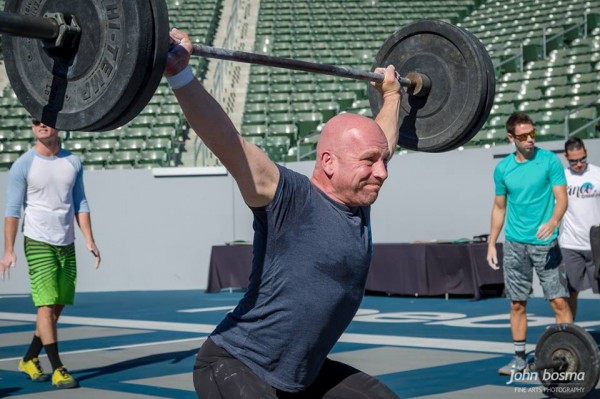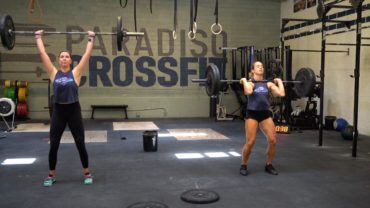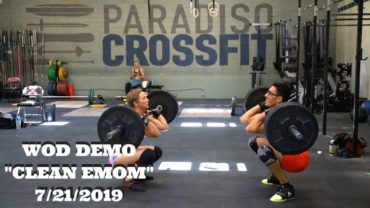Member Spotlight: Dutch Steutel & Mathcon

Matt: How long have you been doing CrossFit/when did you get started at Paradiso?
Dutch: I started Crossfit at the PCF Glencoe box, Spring 2010.
Matt: What are your goals right now?
Dutch: For 5 years I did Crossfit as one of my activities. The last 3 years I really started to enjoy local events and competitions primarily for the community aspect. This year I’ve chosen, with the blessing of my wife, to make training for competing in the sport of Crossfit my main activity. I’ve deprioritized pretty much everything else in my life except for my work.
More training means more sleep and more recovery. There is little time for anything else. It has been a great and satisfying process. My aspiration is to express all this training during the upcoming Open and I aim to make the Masters Qualifier. Numbers are hard to pick but I hope to make it top 1% of the my age bracket. Should it not come together then there are tons of other adventures to take on with all that fitness.
Matt: What is Mathcon?
Dutch: Mathcon is pacing advice for intermediate athletes. If you cannot do a workout unbroken, you want to minimize the accumulated rest time. Most of this pacing advice comes down to, stay under the “redzone”, the zone where your heart beats out of your chest, until your final sprint. Depending on the athlete the final sprint can be 30 seconds to a few minutes.
During the Open you’ll see that there is a lot pacing advice and strategies for elite athletes but pretty much none for the average open participant. Or if if there is any advice for intermediates it mostly doesn’t lead to the best result: Go unbroken as long as you can, suggestions on form (very few can effectively change the form the day of competition).
Mathcon strategies often include more breaks and shorter sets than what most people would expect. The key is to keep the rests really short.
Mathcon is intended to score your best during Open WODs or other competitions. Mathcon is NOT a training method. If you were to Mathcon every WOD, you’d see less training effect than going at high intensity. To do 100 wallballs as a competition element of a chipper, a mathcon strategy could be 20 sets 5 with 3 breath breaks. During a class/training WOD with 100 wallballs, you’ll want to push your sets to 15, 20 or higher to increase your capacity.
“The investment in training creates capacity. Deliberate pacing can maximize the expression of an intermediate athlete’s capacity.”
For a mile run, pacing might be intuitive but for short sets of explosive movements it is often hard guess the right pace on the spot. Even the pros fail sometimes. Every year you see pros without a pacing plan that don’t do well during the announcement show e.g. Garret Fisher, Marcus Hendren, even Camille.
Matt: When did you first test the concept? When did you start testing it with other people?
Dutch: The 150 wallballs, 90 dubs, and MU workout that appeared 2 Opens in a row, really made me think differently about pacing in competitions after I bombed the workout both years. Given that a one wallball takes aprroximately 2 seconds and looking at the total spent on these damn wallballs, I could not believe how much time I spent resting between sets. That same season featured the 100s Chipper at regionals. I heard respected athletes and trainers like Mike McGoldrick, Jaon Khalipa, Bill Grundler, Kris Clever, Lucas Parker, and Rudy Nielsen talk about pacing and heart rate. Khalipa kept shis sets of C2Bs to a max of 5 and won Norcal. I was curious if these same principles could apply for recreational athlete during regular WODs.
The next time Karen came up, I broke up the sets in 5s and 4s with short brakes in between and shaved 2 minutes of my Karen time. From 10 t0 8 minutes (20%) without moving any faster. Murph was the next experiment. I strayed from the old 5-10-15 recommendation and split the pushups in 5s as well. My time went down from 43 to 35 minutes, a few months later I got it down to 32 minutes (no weight vest). I’d shared some of my experiences with people in the next class and the ones who took it all PRed by minutes. Dino and Phil come to mind. In the meantime I’d done a few Saturday partner workouts with Ryan where we’d do the same thing, short high paced sets and short breaks. Many times we’d score better than athletes who were much better individual athletes than we were. This was the summer of 2013. Those who were there will probably agree that the competitive spirit was at its peak at PCF.
Matt: What are some examples of Mathcon success stories?
Dutch: When the 2014 Open came around we launched a Facebook group and people started to share their Open strategies and how their strategies payed off. Like pool players we tried to call our shots and calculate our options: at what point in time we’d be where in the workout and at which points we’d decide to go faster, keep pace, or go slower. Many of us were able to keep up or stay close to athletes we’d deem superior to us. Obviously we were still miles from the elite but that had no effect on our high level of stoke.
The 2015 Open was different. Only the OHS & C2B workout was particularly well suited for mathcon style pacing. The other WODs had mostly shorter sets that could be done unbroken or as quick singles.
During the 2015 World Championship Conga line event the our team aggressively paced the first row and deliberately eased the pace after that to avoid blowing up. We ordered the athletes such that our weaknesses would not cause any hold ups and still leave the smallest possible gap between team members. We won, we shouldn’t have. My eyes were teary when Ali passed the finish line. It is still my fondest Mathcon moment.
[Matt’s Note] If you want to join in and get feedback on your Mathcon strategy, you can join the Facebook group.



















